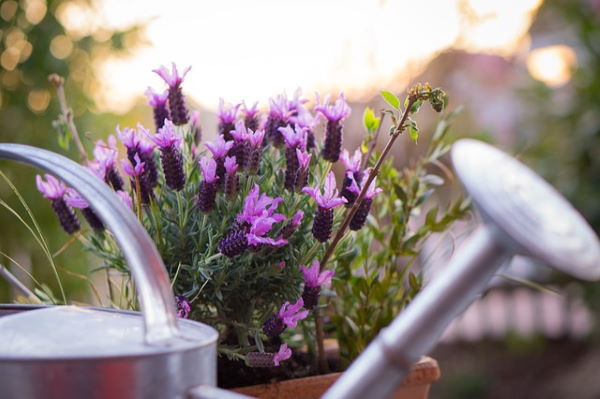How to Grow Lavender
If you've ever wondered how to grow lavender plant, you'll be surprised how easy it is. All lavender varieties prefer full sun and a sandy, well-drained soil. Lavender grows well in a container indoors and out.
 English lavender (L. angustifolia) is the most common variety. It offers several popular cultivars.
English lavender (L. angustifolia) is the most common variety. It offers several popular cultivars.Known botanically as Lavandula, this beautifully scented plant includes many species.
Lavandula angustifolia offers a few cultivars that make good house plants. 'Hidcote' lavender is a compact plant with rich purple blooms, and 'Munstead Dwarf' is a prolific bloomer that only reaches 1 ft (30 cm) tall. 'Alba Nana' is even more compact, growing to 6-12 in (15-30 cm) high and is a rare white-flowered variety.
Uses of Lavender
Lavender gets its name from the Latin word lavare, which means to wash. In ancient times, Romans used the aromatic herb to scent their bathwater.
Lavender's intoxicating fragrance has made this herb a favorite for perfumes and lavender sachets for centuries. Pure lavender oil is used in aromatherapy products such as candles, pot pourri and soaps. Its soothing scent has a relaxing effect. Lavender crafts such as wreaths or other dried flower arrangements are cherished for their aroma as much as their beauty.
Did you know...
Dried lavender flower buds are one of the ingredients in herbes de Provence, a popular herb mix used for cooking.
Varieties of Lavender
L. x intermedia are hybrids of L. angustifolia and L. latifolia, featuring violet-blue flowers. 'Twickle Purple' is a beautiful, dark-purple cultivar with heavy fragrance. 'Hidcote' is compact, reaching 16 in (40 cm), ideal for a container.
French lavender (L. dentata) has finely toothed, grayish-green foliage and pale purple blooms.
Spanish lavender (L. stoechas), shown below, is a species featuring short, thick spikes of deep violet flowers topped with long bracts.
Countless varieties are available, but the basics for how to grow lavender are the same for all. Provide plenty of sunshine and keep the soil on the dry side.
 Spanish lavender makes a beautiful and fragrant potted plant. Photo: Andreas Riedelmeier
Spanish lavender makes a beautiful and fragrant potted plant. Photo: Andreas RiedelmeierLavender Plant Care
There's no trick to learn how to grow lavender. However, growing lavender plant indoors can be a challenge if you don't have a sunny spot for it.
Native to the Mediterranean, this sun-loving herb needs as much direct light as possible. It can tolerate a wide range of temperatures, so moving it outdoors for the summer may be your best option. Don't worry about putting it on a hot porch or patio -- it can take the heat. Just bring it back indoors for the winter. Most lavender varieties are not cold-hardy.
Pruning lavender will keep the plant compact. Cut the plant back by half after the flowering season is over.
Lavender Harvesting Tip
If you want to preserve the plant for drying, gather lavender just after the flowers open. Cut flower stems at the base.
How to Dry Lavender
Cut off the stems as soon as the flowers are fully open, leaving a stem length suitable for a vase, wreath, or whatever flower arrangement you choose. Use a dark, dry, airy room for fast drying. Tie the stems in small bunches, then hang the stems upside down while drying to prevent them from bending.
It will take about a week for the flowers to completely dry.
How to Grow Lavender Indoors

Origin: Mediterranean
Height: 1-3 ft (30-90 cm), depending on variety
Light: Full sun. Turn plant for even growth because it will tend to grow toward the light source. Growing lavender plant outdoors in the warm months will give it the sunlight it needs.
Water: Water thoroughly spring through fall, allowing the soil to dry out slightly between waterings. In winter, water sparingly. Use a pot with a drainage hole to prevent soggy potting medium, which can lead to root rot.
Humidity: Average room (around 40% relative humidity).
Temperature: Average room temperatures 60-80°F/16-27°C. English lavender (L. angustifolia) is cold hardy to USDA Zone 5. Other lavender varieties are not cold-hardy. They do, however, make excellent container plants and can be brought indoors for the winter.
Soil: Use a well-drained potting mix such as 2 parts all-purpose potting mix and 1 part sand. Lavender doesn't like heavy, poorly drained soil, which can cause root rot.
Fertilizer: Feed every 2 weeks spring through fall with a 10-20-20 liquid fertilizer diluted by half.
Propagation: Take 3-4 in (7-10 cm) stem cuttings in spring and place in moist potting mix. Pinch off the flowers the first year to encourage strong growth of the plant. Propagating lavender from seed is usually difficult, however, one variety L. angustifolia 'Lady' is easy to start from seed and will bloom the first year. How to grow lavender from seed: Sow in spring, just barely covering the seeds with well-drained soil. Place in full sun.


